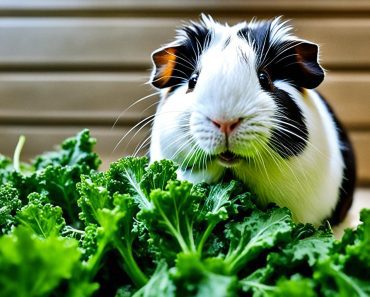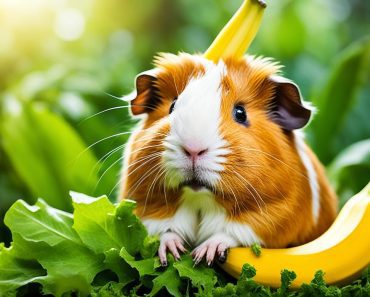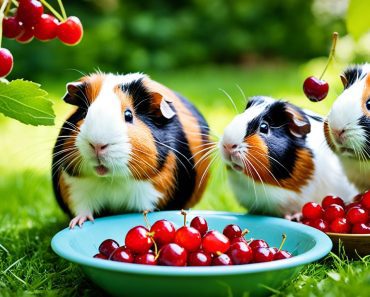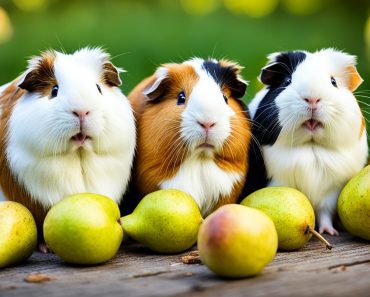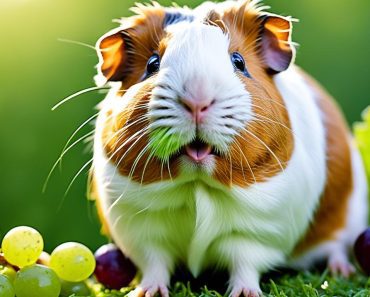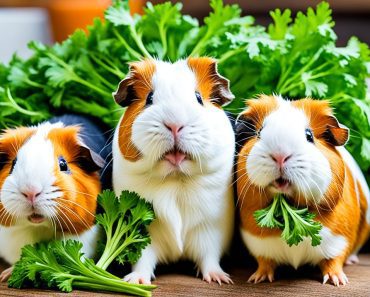Are you a proud guinea pig owner wondering if they can enjoy the tropical sweetness of pineapple? Well, you’re in the right place! In this article, I’ll answer your burning question: Can guinea pigs eat pineapple? Stick around as I share safe treat tips for your furry friend’s pineapple consumption.
Pineapple can offer some nutritional benefits to guinea pigs, but it’s important to ensure their safety and well-being when introducing new foods. Let’s dive into the details and shed some light on guinea pig diet guidelines when it comes to pineapple.
Can Guinea Pigs Eat Pineapple? Yes, in small portions.
- Guinea pigs can eat pineapple in moderation.
- Pineapple contains important nutrients like vitamin C, calcium, and phosphorus.
- Introduce pineapple slowly and monitor your guinea pig for any adverse reactions.
- Feed one square-inch cube of pineapple once a week.
- Properly prepare pineapple by removing leaves, skin, and core.
The Nutritional Benefits of Pineapple for Guinea Pigs
Pineapple is a nutritious fruit for guinea pigs. It is rich in vitamin C, which helps strengthen the immune system and prevent scurvy. Pineapple also contains calcium and phosphorus, which are essential for the formation and maintenance of strong bones. Additionally, the magnesium in pineapple supports muscle and nerve function, regulates blood pressure, and aids in blood clotting. Pineapple is low in calories and fat, making it a heart-healthy treat for guinea pigs.
The Nutritional Benefits of Pineapple for Guinea Pigs
| Nutrient | Function |
|---|---|
| Vitamin C | Strengthens the immune system and prevents scurvy |
| Calcium | Essential for bone formation and maintenance |
| Phosphorus | Supports bone health and energy metabolism |
| Magnesium | Aids in muscle and nerve function, regulates blood pressure, and promotes blood clotting |
| Low in calories and fat | Heart-healthy treat option for guinea pigs |
Include pineapple in your guinea pig’s diet to provide these essential nutrients for their overall health and well-being. However, remember to feed pineapple in moderation and monitor your guinea pig for any adverse reactions. It’s always best to introduce any new food slowly and observe how your guinea pig responds to it.
Potential Risks of Feeding Pineapple to Guinea Pigs
While pineapple can provide health benefits to guinea pigs, it’s essential to be aware of potential risks associated with its consumption. Feeding pineapple to guinea pigs can result in certain health issues if not done in moderation.
1. Diarrhea:
The high sugar content in pineapple can cause digestive upset in guinea pigs, leading to diarrhea. Excess consumption of pineapple or any other sugary fruit should be avoided to prevent this issue.
2. Kidney Stones:
One potential risk of feeding pineapple to guinea pigs is the excessive intake of calcium. Pineapple, along with other foods, contains calcium, and consuming too much can increase the likelihood of developing kidney stones. Monitoring your guinea pig’s calcium intake is crucial to prevent this issue.
It’s important to remember that pineapple should be considered a treat and not a staple in a guinea pig’s diet. Feeding pineapple in moderation and observing your guinea pig for any adverse reactions is essential to maintain their overall health and well-being.
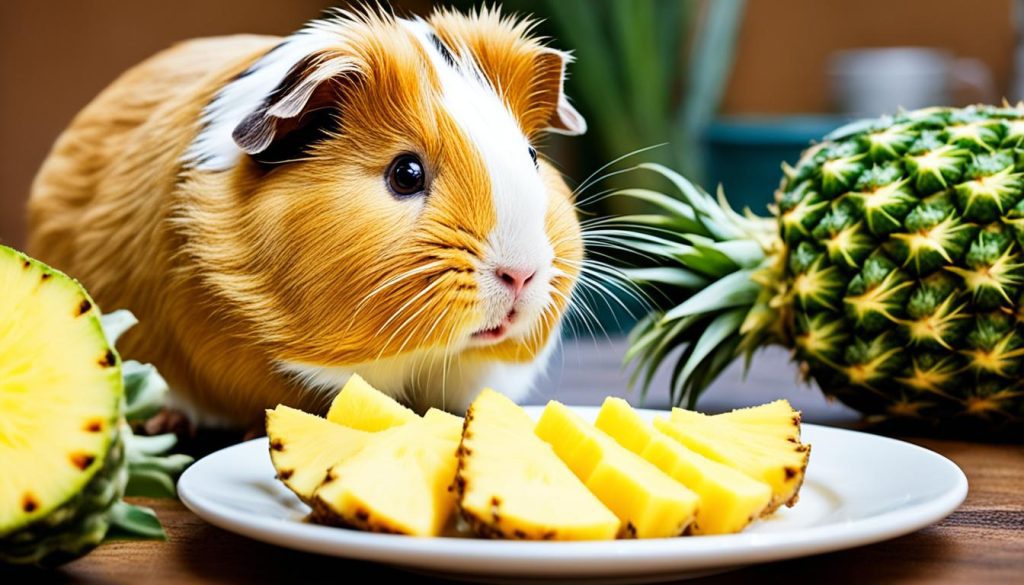
- Start with a small amount to assess their tolerance.
- Observe any changes in their digestive system, such as loose stools or diarrhea.
- Limit the quantity to prevent excessive sugar intake.
By following these guidelines and consulting with a veterinarian, you can ensure your guinea pig enjoys pineapple as a safe and enjoyable treat.
| Risks of Feeding Pineapple to Guinea Pigs | Precautions |
|---|---|
| Diarrhea | Feed pineapple in moderation to prevent excessive sugar intake. |
| Kidney Stones | Monitor calcium intake from pineapple and other foods to prevent the development of kidney stones. |
Serving Pineapple to Your Guinea Pig
When it comes to serving pineapple to your guinea pig, it’s important to remember that moderation is key. Proper preparation is essential to ensure your furry friend can enjoy this tasty treat safely. Follow these guidelines to serve pineapple to your guinea pig:
- Cut fresh pineapple into small cubes, removing the leaves, skin, and tough core.
- Start by introducing a small amount of pineapple to your guinea pig’s diet, observing for any adverse reactions or changes in waste output.
- Feed one square-inch cube of pineapple to your guinea pig once a week.
- Monitor your guinea pig’s digestion and overall well-being. If your guinea pig experiences any digestive issues or discomfort, it is recommended to discontinue feeding pineapple.
Remember, pineapples are a treat and should not replace the main components of your guinea pig’s diet, such as fresh hay and high-quality pellets. By offering pineapple in moderation and maintaining a balanced diet, you can ensure your guinea pig enjoys this fruity delicacy without any health concerns.
Expert Tip:
“When introducing pineapple to your guinea pig’s diet, it’s always better to start with a smaller amount and gradually increase the serving size. This way, you can closely monitor your guinea pig’s response and adjust accordingly.” – Dr. Ava Williams, DVM
Now that you know how to serve pineapple to your guinea pig, let’s explore some alternative treats to keep your furry friend happy and healthy!
| Treat | Description |
|---|---|
| Strawberries | High in vitamin C and antioxidants, strawberries make a delicious and nutritious treat for guinea pigs. |
| Melons | Watermelon and cantaloupe are hydrating and low in sugar, providing a refreshing treat for guinea pigs. |
| Apples | Rich in fiber, apples can be given to guinea pigs as long as the seeds and core are removed. |
| Spinach | Leafy greens like spinach are packed with nutrients and can be served in small amounts as an occasional treat. |
Alternatives to Pineapple for Guinea Pig Treats
While pineapple can be a tasty treat for guinea pigs, there are other options that can provide similar health benefits. It’s important to vary your guinea pig’s diet and offer a balanced mix of fruits, vegetables, and hay. Here are some alternatives to pineapple that your guinea pig might enjoy:
1. Strawberries
Strawberries are a delicious and nutritious treat for guinea pigs. They are low in sugar and contain vitamin C, which is essential for their overall health. Remember to wash strawberries thoroughly and remove the stem before feeding them to your guinea pig.
2. Melons
Melons like watermelon and cantaloupe are hydrating and refreshing for guinea pigs. They are low in calories and high in water content, making them a healthy option for a summer treat. Remove the seeds and rind before serving melons to your furry friend.
3. Apples
Apples are a crunchy and nutritious snack for guinea pigs. They are a good source of fiber and vitamin C. Remember to remove the seeds and core, as they can be choking hazards. Cut the apple into small, bite-sized pieces before offering it to your guinea pig.
4. Leafy Greens
Leafy greens like spinach and kale are packed with essential vitamins and minerals. They provide a variety of nutrients that can support your guinea pig’s overall well-being. Offer a mix of different greens to ensure a well-rounded diet.
Remember to introduce new foods gradually and monitor your guinea pig for any digestive issues. Every guinea pig is unique, so it’s important to observe their preferences and adjust their diet accordingly.
Offering a variety of fruits, vegetables, and hay will ensure that your guinea pig receives the necessary nutrients for optimal health. Remember, treats should only make up a small portion of their overall diet. Consult with a veterinarian for personalized dietary recommendations for your guinea pig.
| Treat Options | Key Benefits |
|---|---|
| Strawberries | Low in sugar, rich in vitamin C |
| Melons | Hydrating, low in calories |
| Apples | Source of fiber, vitamin C |
| Leafy Greens | Rich in essential nutrients |
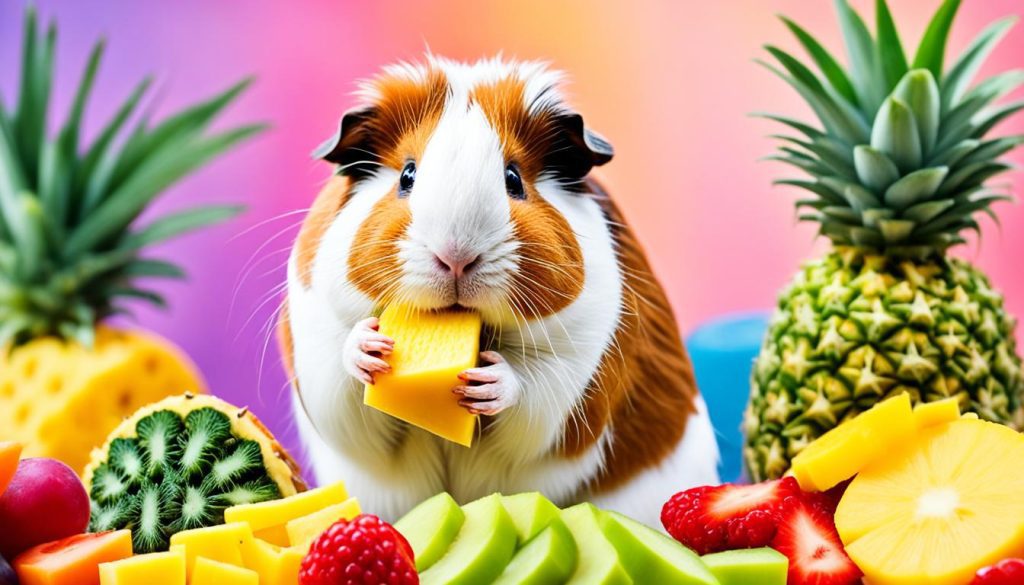
What Not to Feed Your Guinea Pig
While pineapple can be safely fed to guinea pigs in moderation, it’s important to be aware of other foods that should be avoided. Some examples include:
- Chocolate: Chocolate contains theobromine, which is toxic to guinea pigs and can cause various health issues.
- Caffeine: Caffeine can have harmful effects on the nervous system of guinea pigs and should be avoided.
- Onions: Onions contain compounds that can damage a guinea pig’s red blood cells, leading to anemia.
- Garlic: Garlic can have similar effects to onions and should be avoided for the same reasons.
- Avocado: Avocado contains a substance called persin, which is toxic to guinea pigs and can cause gastrointestinal issues.
It’s important to research and consult a veterinarian for a comprehensive list of foods to avoid and ensure your guinea pig’s diet meets their nutritional needs. Always prioritize the health and well-being of your furry friend by providing a safe and appropriate diet.
Foods to Avoid Feeding Your Guinea Pig
| Food | Reason to Avoid |
|---|---|
| Chocolate | Theobromine content is toxic to guinea pigs. |
| Caffeine | Harmful effects on the nervous system. |
| Onions | Can damage red blood cells, leading to anemia. |
| Garlic | Similar effects to onions, including anemia. |
| Avocado | Persin content can cause gastrointestinal issues. |
The Importance of a Balanced Guinea Pig Diet
Pineapple should be viewed as a treat rather than a staple in a guinea pig’s diet. It’s important to provide a balanced diet for your guinea pig to ensure their optimal health and well-being.
A balanced guinea pig diet should include:
- Fresh Hay: High-quality hay such as timothy hay should make up the majority of your guinea pig’s diet. It provides essential fiber for proper digestion and helps wear down their teeth.
- High-Quality Pellets: Choose pelleted food specifically formulated for guinea pigs. Look for pellets that are low in sugar and high in fiber to maintain a healthy weight.
- Fresh Fruits and Vegetables: Offer a variety of fresh produce to provide essential nutrients. Along with pineapple, you can include other guinea pig-friendly fruits and vegetables like leafy greens, bell peppers, and carrots.
It’s important to remember that guinea pigs have sensitive digestive systems, so introduce new foods gradually and monitor their reaction. Pay attention to their weight and adjust their portions accordingly. Consult with a veterinarian or guinea pig specialist for specific dietary recommendations based on your pet’s age, weight, and overall health.
Conclusion
Guinea pigs can safely enjoy pineapple as a treat in moderation. Pineapple provides valuable nutrients, including vitamin C, calcium, and phosphorus, which contribute to the overall health of guinea pigs. However, it is essential to introduce pineapple slowly into their diet and closely observe for any adverse reactions. To ensure safe consumption, it is recommended to feed one square-inch cube of properly prepared pineapple once a week. Remember, removing the leaves, skin, and core is necessary for their well-being.
While pineapple can be a beneficial addition to a guinea pig’s diet, it should not be the primary source of nutrition. A well-balanced diet for guinea pigs consists of fresh hay, high-quality pellets, and a variety of vegetables and fruits. Consult a veterinarian for personalized advice on maintaining a healthy and nutritious diet for your guinea pig.
By offering pineapple as a treat alongside a balanced diet, you can indulge your guinea pig while promoting its overall well-being. Remember to monitor its consumption, follow moderation guidelines, and prioritize their dietary needs for a happy and healthy furry companion.

